Identification of Inertial Parameters for Position and Force Control of Surgical Assistance Robots
Abstract
1. Introduction
2. Kinematic Model of Surgical Assistance Robot
2.1. Design Specifications
2.2. Denavit–Hartenberg Parameters
3. Identification of Inertial Parameters
4. Calculation of External Force at End of the Manipulator
5. Methodology: Implementation in the Actual Robot
5.1. Surgery Assistance Robot
5.2. Calculation of Inertial Parameters
5.3. Calculation of External Forces
6. Results and Discussion
7. Conclusions
Author Contributions
Funding
Institutional Review Board Statement
Informed Consent Statement
Data Availability Statement
Conflicts of Interest
References
- Nagatani, K.; Kiribayashi, S.; Okada, Y.; Tadokoro, S.; Nishimura, T.; Yoshida, T.; Koyanagi, E.; Hada, Y. Redesign of Rescue Mobile Robot Quince—Toward Emergency Response to the Nuclear Accident at Fukushima Daiichi Nuclear Power Station on March 2011. In Proceedings of the 9th IEEE International Symposium on Safety, Security, and Rescue Robotics, Kyoto, Japan, 1–5 November 2011; pp. 13–18. [Google Scholar] [CrossRef]
- Du Toit, N.E.; Burdick, J.W. Robot Motion Planning in Dynamic, Uncertain Environments. IEEE Trans. Robot. 2012, 28, 101–115. [Google Scholar] [CrossRef]
- Körtner, T.; Schmid, A.; Batko-Klein, D.; Gisinger, C.; Huber, A.; Lammer, L.; Vincze, M. How Social Robots Make Older Users Really Feel Well—A Method to Assess Users’ Concepts of a Social Robotic Assistant. In Social Robotics. ICSR 2012; Ge, S.S., Khatib, O., Cabibihan, J.J., Simmons, R., Williams, M.A., Eds.; Lecture Notes in Computer Science; Springer: Berlin/Heidelberg, Germany, 2012; Volume 7621. [Google Scholar] [CrossRef]
- Mukai, T.; Hirano, S.; Nakashima, H.; Kato, Y.; Sakaida, Y.; Guo, S.; Hosoe, S. Development of a Nursing-Care Assistant Robot RIBA That Can Lift a Human in Its Arms. In Proceedings of the IEEE/RSJ 2010 International Conference on Intelligent Robots and Systems, IROS 2010—Conference Proceedings, Taipei, Taiwan, 18–22 October 2010; pp. 5996–6001. [Google Scholar] [CrossRef]
- Shibata, T. Therapeutic Seal Robot as Biofeedback Medical Device: Qualitative and Quantitative Evaluations of Robot Therapy in Dementia Care. Proc. IEEE 2012, 100, 2527–2538. [Google Scholar] [CrossRef]
- Lo, A.C.; Guarino, P.D.; Richards, L.G.; Haselkorn, J.K.; Wittenberg, G.F.; Federman, D.G.; Ringer, R.J.; Wagner, T.H.; Krebs, H.I.; Volpe, B.T.; et al. Robot-Assisted Therapy for Long-Term Upper-Limb Impairment after Stroke. N. Engl. J. Med. 2010, 362, 1772–1783. [Google Scholar] [CrossRef] [PubMed]
- Gillinov, A.M.; Mihaljevic, T.; Javadikasgari, H.; Suri, R.M.; Mick, S.L.; Navia, J.L.; Desai, M.Y.; Bonatti, J.; Khosravi, M.; Idrees, J.J.; et al. Early Results of Robotically Assisted Mitral Valve Surgery: Analysis of the First 1000 Cases. J. Thorac. Cardiovasc. Surg. 2018, 155, 82–91.e2. [Google Scholar] [CrossRef]
- Melfi, F.M.A.; Menconi, G.F.; Mariani, A.M.; Angeletti, C.A. Early Experience with Robotic Technology for Thoracoscopic Surgery. Eur. J. Cardio-Thorac. Surg. 2002, 21, 864–868. [Google Scholar] [CrossRef]
- Colan, J.; Nakanishi, J.; Aoyama, T.; Hasegawa, Y. A Cooperative Human-Robot Interface for Constrained Manipulation in Robot-Assisted Endonasal Surgery. Appl. Sci. 2020, 10, 4809. [Google Scholar] [CrossRef]
- Hyun, M.; Lee, C.; Kim, H.; Tong, Y.; Park, S. Systematic Review and Meta-Analysis of Robotic Surgery Compared with Conventional Laparoscopic and Open Resections for Gastric Carcinoma Systematic Review Systematic Review and Meta-Analysis of Robotic Surgery Compared with Conventional Laparoscopic and Open Resections for Gastric Carcinoma. Br. J. Surg. 2013, 100, 1566–1578. [Google Scholar] [CrossRef] [PubMed]
- Ramsay, C.; Pickard, R.; Robertson, C.; Close, A.; Vale, L.; Armstrong, N.; Barocas, D.A.; Eden, C.G.; Fraser, C.; Gurung, T.; et al. Systematic Review and Economic Modelling of the Relative Clinical Benefit and Cost-Effectiveness of Laparoscopic Surgery and Robotic Surgery for Removal of the Prostate in Men with Localised Prostate Cancer. Health Technol. Assess. 2012, 16, 1. [Google Scholar] [CrossRef]
- Fanning, J.; Fenton, B.; Purohit, M. Robotic Radical Hysterectomy. Am. J. Obstet. Gynecol. 2008, 198, 649.e1–649.e4. [Google Scholar] [CrossRef]
- Huang, Y.; Duan, K.; Koythong, T.; Patil, N.M.; Fan, D.; Liu, J.; Guan, Z.; Guan, X. Application of Robotic Single-Site Surgery with Optional Additional Port for Endometriosis: A Single Institution’s Experience. J. Robot. Surg. 2021. [Google Scholar] [CrossRef]
- Trochimczuk, R.; Łukaszewicz, A.; Mikołajczyk, T.; Aggogeri, F.; Borboni, A. Finite Element Method Stiffness Analysis of a Novel Telemanipulator for Minimally Invasive Surgery. Simulation 2019, 95, 1015–1025. [Google Scholar] [CrossRef]
- Dimaio, S.; Hanuschik, M.; Kreaden, U. The Da Vinci Surgical System. In Surgical Robotics: Systems Applications and Visions; Springe: Berlin/Heidelberg, Germany, 2011; pp. 199–217. [Google Scholar] [CrossRef]
- Desai, P.H.; Gillentine, R.J. Present Challenges of Robotics in Gynecology; IntechOpen: London, UK, 2021. [Google Scholar] [CrossRef]
- Freschi, C.; Ferrari, V.; Melfi, F.; Ferrari, M.; Mosca, F.; Cuschieri, A. Technical Review of the Da Vinci Surgical Telemanipulator. Int. J. Med. Robot. Comput. Assist. Surg. 2013, 9, 396–406. [Google Scholar] [CrossRef] [PubMed]
- Gültekin, İ.B.; Karabük, E.; Köse, M.F. “Hey Siri! Perform a Type 3 Hysterectomy. Please Watch out for the Ureter!” What Is Autonomous Surgery and What Are the Latest Developments? J. Turk. Ger. Gynecol. Assoc. 2021, 22, 58–70. [Google Scholar] [CrossRef] [PubMed]
- Deckardt, R.; Saks, M.; Graeff, H. Laparoscopic Hysterectomy. Gynäkologisch-Geburtshilfliche Rundsch. 1993, 33 (Suppl. S1), 274. [Google Scholar] [CrossRef] [PubMed]
- Lo más Destacado Laparoscopia en la Ginecología|KARL STORZ Endoskope|España. Available online: https://www.karlstorz.com/es/es/highlights-lap-gyn.htm (accessed on 18 February 2021).
- Cirugía Laparoscópica, Robótica y Abierta. Available online: https://www.conmed.com/es/products/laparoscopic-robotic-and-open-surgery (accessed on 14 March 2021).
- Gustavo, L.; Baños, G.; Barreras González, J.E.; Días Ortega, I.; Castillo Sánchez, Y.; Gerardo, J.; Fraga, P.; Bertha, A.; Milhet, L. Manipulador Uterino “KD” Como Nuevo Dispositivo Para La Histerectomía Totalmente Laparoscópica Uterine Manipulator “KD” as a New Device for the Fully Laparoscopic Hysterectomy. Rev. Cubana Cirugía 2018, 57, 1–9. [Google Scholar]
- Cook, J.R.; O’Shea, R.T.; Seman, E.I. Laparovaginal Hysterectomy: A Decade of Evolution. Aust. N. Z. J. Obstet. Gynaecol. 2004, 44, 111–116. [Google Scholar] [CrossRef]
- Beer, F.P.; Johnston, E.R.; Dewolf, J.T.; Mazurek, D.F. Statics and Mechanics of Materials; McGraw-Hill Companies, Inc.: New York, NY, USA, 2011. [Google Scholar]
- Geladi, P.; Kowalski, B.R. Partial Least-Squares Regression: A Tutorial. Anal. Chim. Acta 1986, 185, 1–17. [Google Scholar] [CrossRef]
- Alvin, C.; Rencher; William, F. Methods of Multivariate Analysis—Christensen—Google Llibres. Available online: https://books.google.es/books?id=0g-PAuKub3QC&pg=PA19&redir_esc=y#v=onepage&q&f=false (accessed on 15 February 2021).
- Quantifying Measurement: The Tyranny of Numbers (Libro-e, 2016). Available online: https://www.worldcat.org/title/quantifying-measurement-the-tyranny-of-numbers/oclc/962422324 (accessed on 15 February 2021).
- Corke, P.I. A Simple and Systematic Approach to Assigning Denavit-Hartenberg Parameters. IEEE Trans. Robot. 2007, 23, 590–594. [Google Scholar] [CrossRef]
- Díaz-Rodríguez, M.; Mata, V.; Valera, Á.; Page, Á. A Methodology for Dynamic Parameters Identification of 3-DOF Parallel Robots in Terms of Relevant Parameters. Mech. Mach. Theory 2010, 45, 1337–1356. [Google Scholar] [CrossRef]
- Martino, L.; Read, J. A Joint Introduction to Gaussian Processes and Relevance Vector Machines with Connections to Kalman Filtering and Other Kernel Smoothers. arXiv 2020, arXiv:2009.09217. [Google Scholar]
- A Correspondence between Bayesian Estimation on Stochastic Processes and Smoothing by Splines on JSTOR. Available online: https://www.jstor.org/stable/2239347?seq=1 (accessed on 23 March 2021).
- Pires, J.N. Force Control Experiments for Industrial Applications: A Test Case Using an Industrial Deburring Example. Assem. Autom. 2007, 27, 148–156. [Google Scholar] [CrossRef]
- Universidad Tecnológica Nacional, F.R.B.A. “Fórmulas”, Probabilidad y Estadística. Cs. Básicas. U.D.B. Matemática. Editorial CEIT-FRBA. (Código BM2BT2), Ed. 2010. Available online: http://ftpmirror.your.org/pub/wikimedia/images/wikipedia/commons/d/d1/Estadistica_Matematica_I.pdf (accessed on 23 March 2021).
- Díaz Rodríguez, M.Á. Identificación de Parámetros Dinámicos de Robots Paralelos Basada en un Conjunto de Parámetros Significativos; Universitat Politècnica de València: Valencia, Spain, 2009. [Google Scholar] [CrossRef]
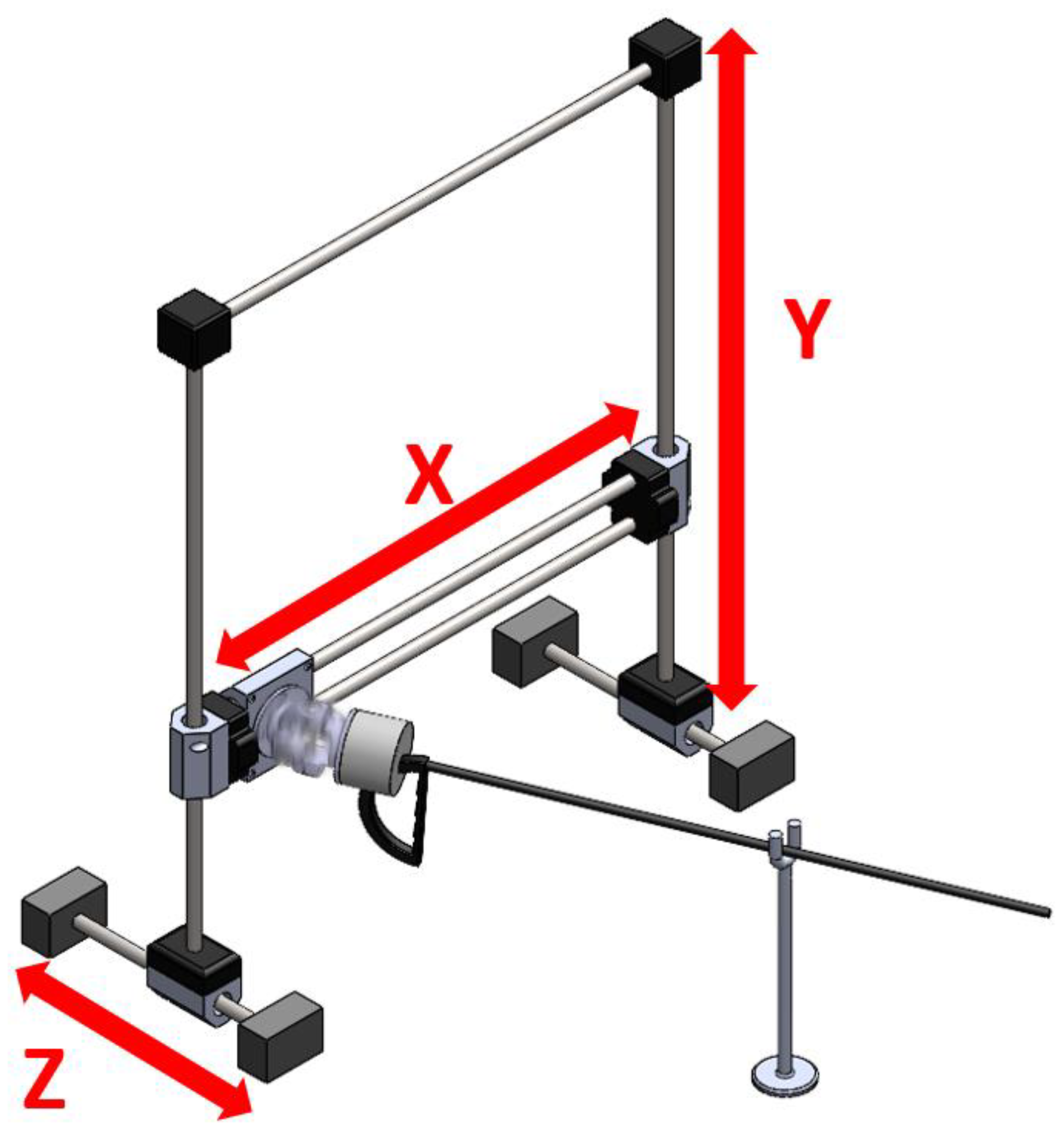
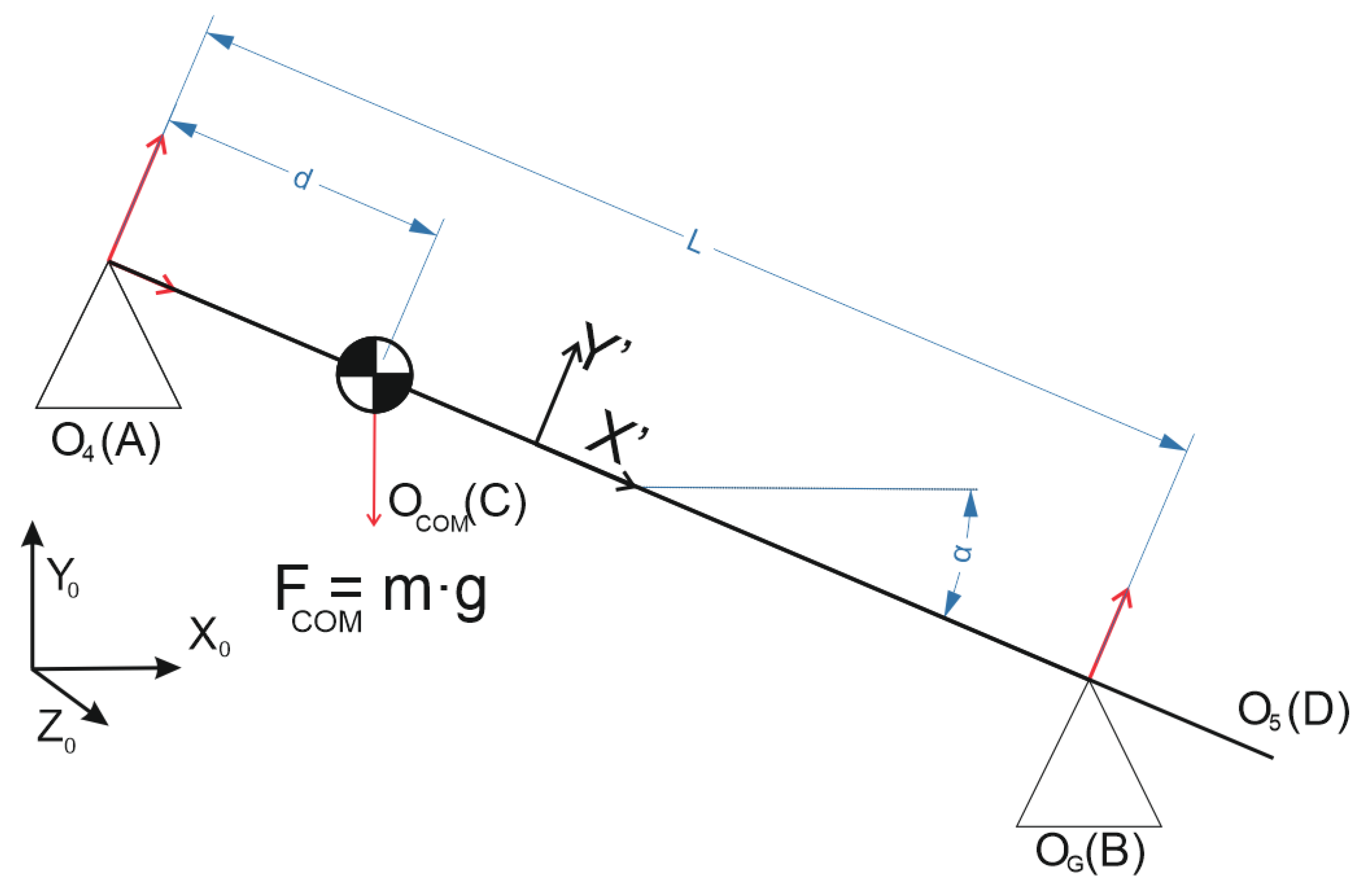

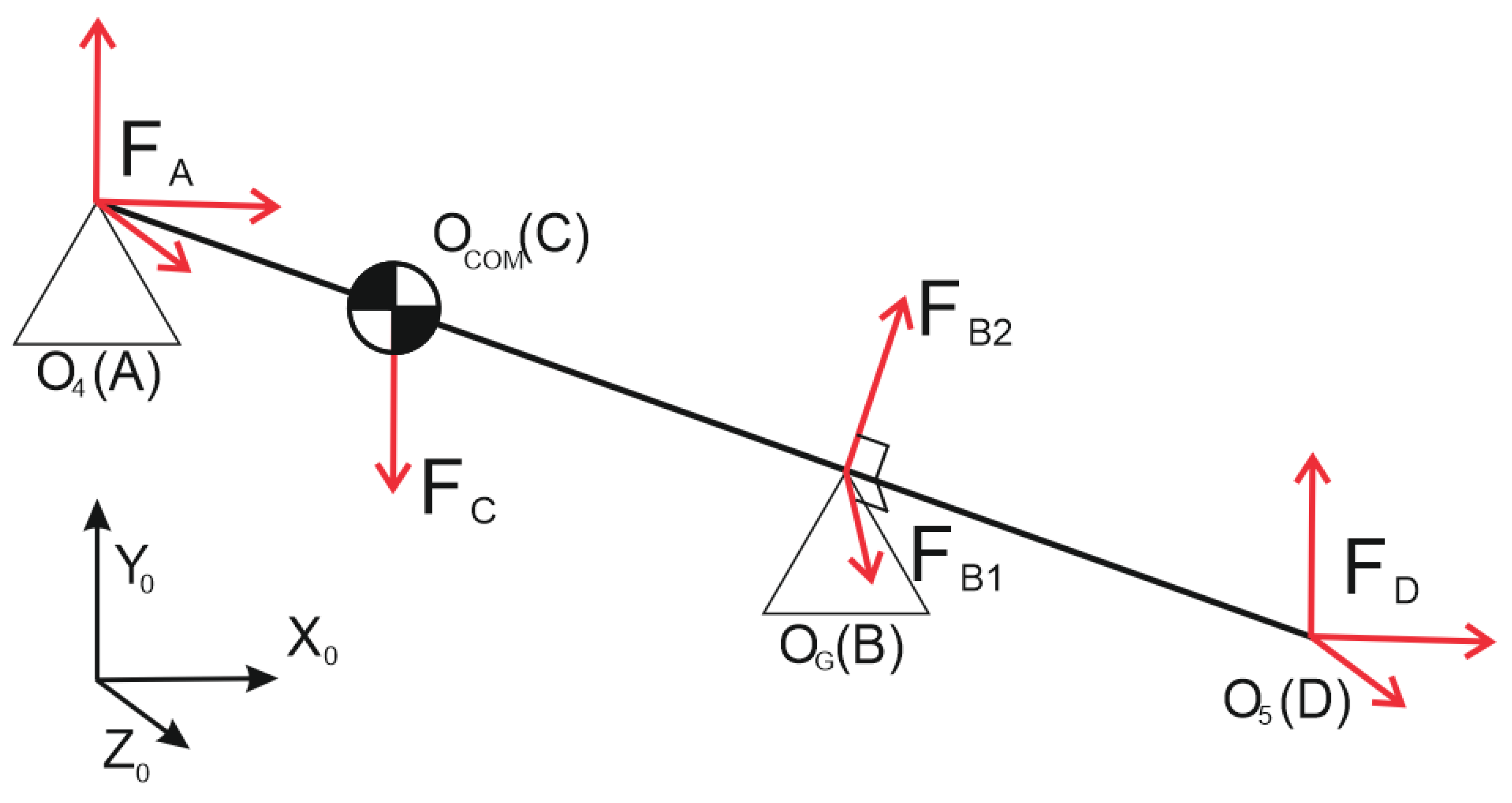

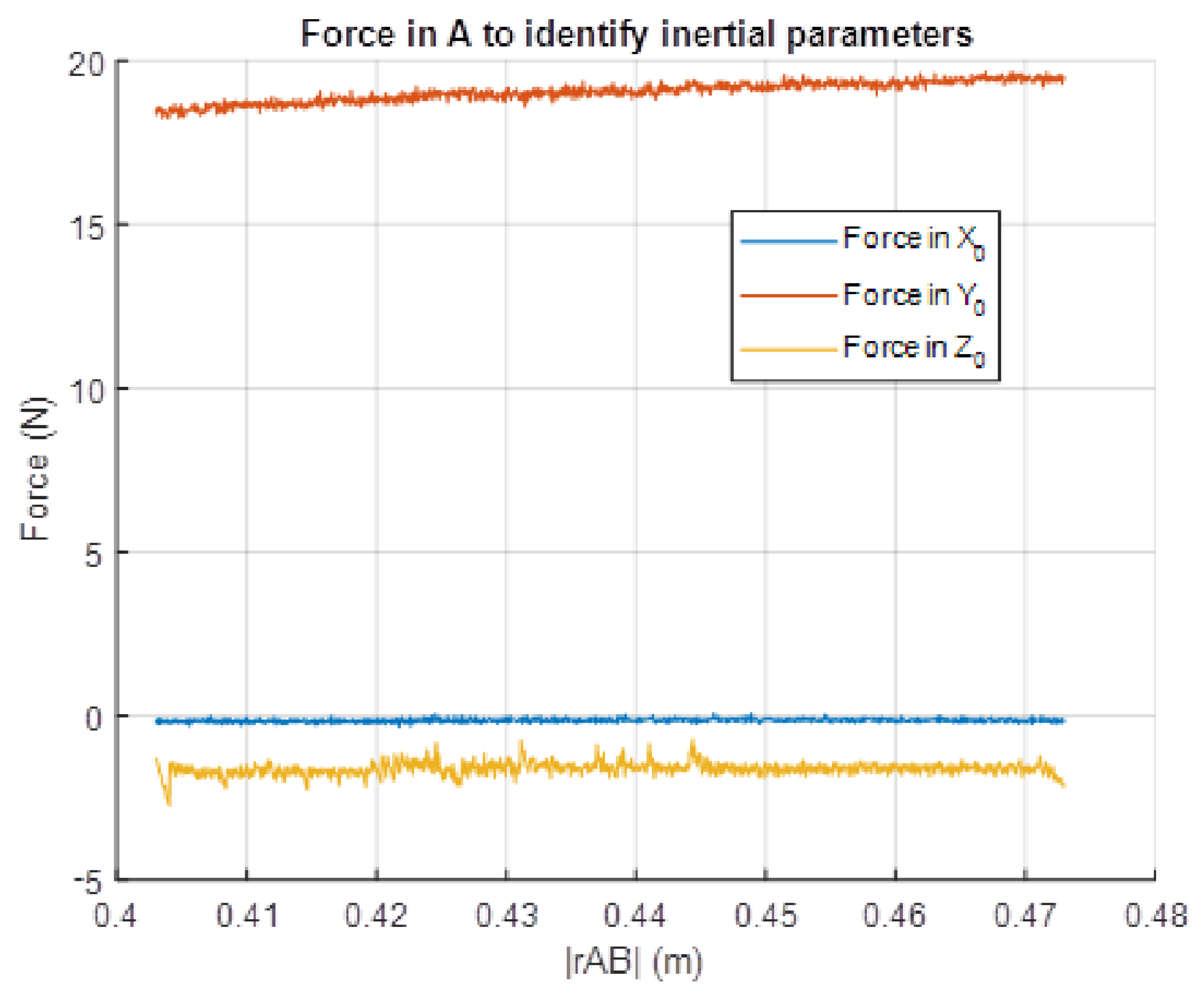
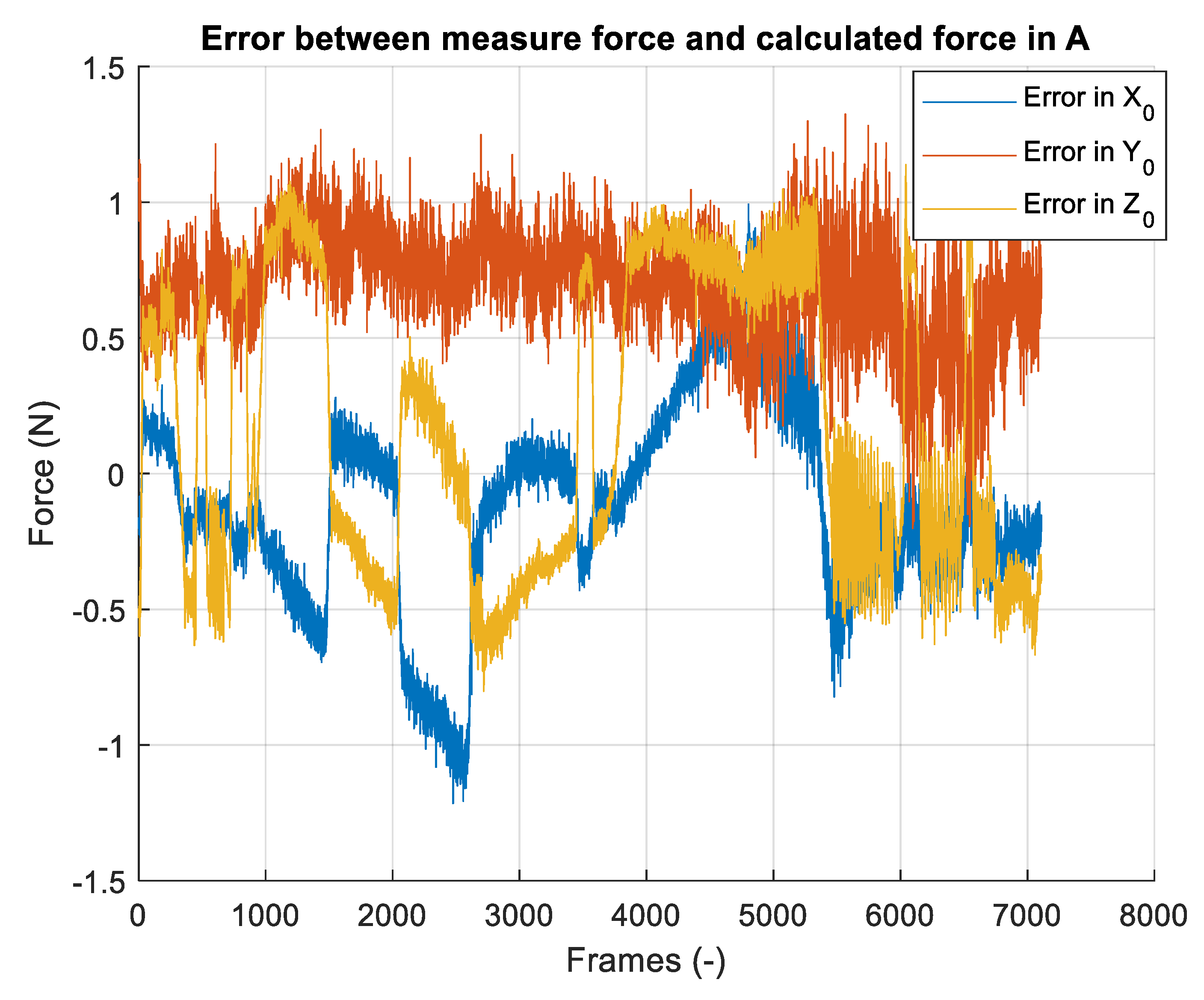

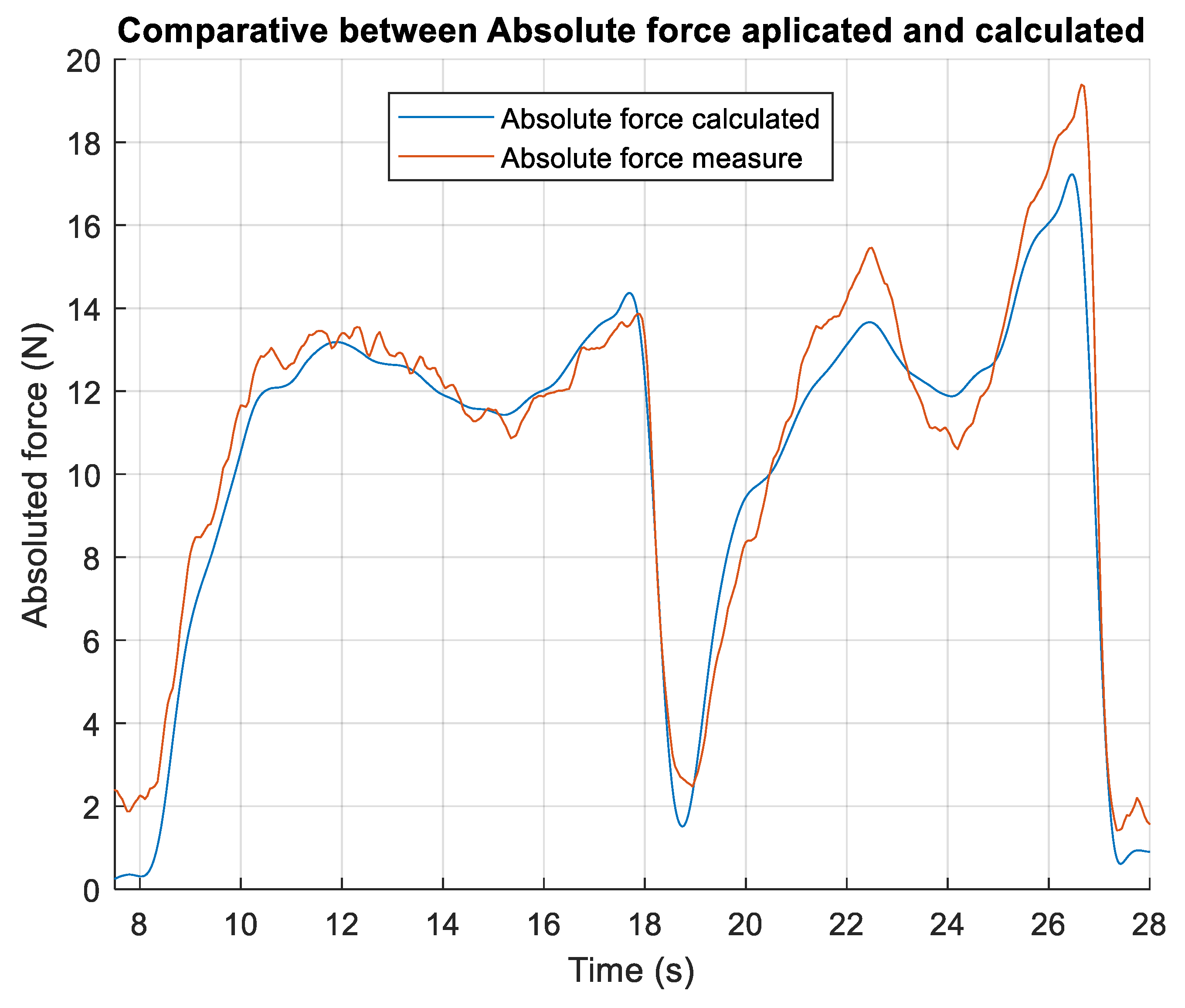
| j | α1j | a1j | d1j | θ1j |
|---|---|---|---|---|
| 1 | 0 | q1 | 0 | −π/2 |
| 2 | −π/2 | q2 | 0 | −π/2 |
| 3 | 0 | q3 | 0 | 0 |
| 4 | q4 | 0 | 0 | π/2 |
| 5 | q5 | d | L | 0 |
| Real | Calculated | Error | ||||
|---|---|---|---|---|---|---|
| Name | Mass (kg) | COM (m) | Mass (kg) | COM (m) | Mass (kg) | COM (m) |
| Manipulator 1 | 1.611 | 0.115 | 1.538 | 0.1129 | −4.53% | −1.83% |
| Manipulator 2 | 2.593 | 0.103 | 2.5602 | 0.1055 | −1.26% | 2.43% |
| Manipulator 3 | 3.198 | 0.125 | 3.2208 | 0.1303 | 0.71% | 4.24% |
| Manipulator 4 | 4.159 | 0.1456 | 4.206 | 0.1398 | 1.13% | −3.98% |
| Mean | −0.99% | 0.21% | ||||
| Standard deviation | 2.58% | 3.78% | ||||
| Mass Applicated (kg) | Mass Calculated (kg) | Error |
|---|---|---|
| 0.51 | 0.5061 | −0.765% |
| 1.03 | 1.013 | −1.650% |
| 2.04 | 2.030 | 0.490% |
Publisher’s Note: MDPI stays neutral with regard to jurisdictional claims in published maps and institutional affiliations. |
© 2021 by the authors. Licensee MDPI, Basel, Switzerland. This article is an open access article distributed under the terms and conditions of the Creative Commons Attribution (CC BY) license (https://creativecommons.org/licenses/by/4.0/).
Share and Cite
Zamora-Ortiz, P.; Carral-Alvaro, J.; Valera, Á.; Pulloquinga, J.L.; Escarabajal, R.J.; Mata, V. Identification of Inertial Parameters for Position and Force Control of Surgical Assistance Robots. Mathematics 2021, 9, 773. https://doi.org/10.3390/math9070773
Zamora-Ortiz P, Carral-Alvaro J, Valera Á, Pulloquinga JL, Escarabajal RJ, Mata V. Identification of Inertial Parameters for Position and Force Control of Surgical Assistance Robots. Mathematics. 2021; 9(7):773. https://doi.org/10.3390/math9070773
Chicago/Turabian StyleZamora-Ortiz, Pau, Javier Carral-Alvaro, Ángel Valera, José L. Pulloquinga, Rafael J. Escarabajal, and Vicente Mata. 2021. "Identification of Inertial Parameters for Position and Force Control of Surgical Assistance Robots" Mathematics 9, no. 7: 773. https://doi.org/10.3390/math9070773
APA StyleZamora-Ortiz, P., Carral-Alvaro, J., Valera, Á., Pulloquinga, J. L., Escarabajal, R. J., & Mata, V. (2021). Identification of Inertial Parameters for Position and Force Control of Surgical Assistance Robots. Mathematics, 9(7), 773. https://doi.org/10.3390/math9070773








